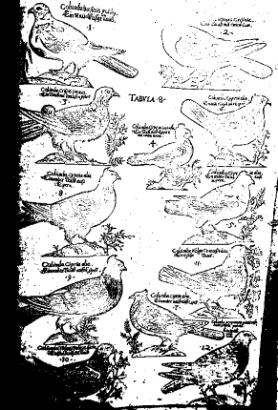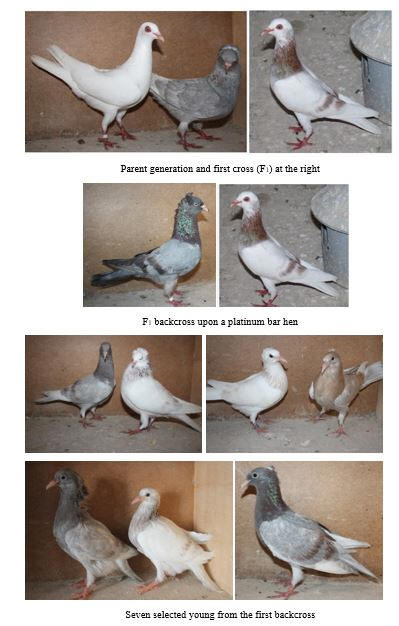|
Crests in the Domestic Pigeon
As basic forms of the crest are distinguished the peak crest and the
round or shell crest, which differ within the sub-groups even in
details. This concerns the fullness of the feathers, with the shell
crest the side closure by a rosette or not, the height of the
attachment in the neck, etc.

Basis form of the feather crest: Peak-crest, round or shell-crest
lacking rosettes and with rosettes. Photos Layne Gardner, Source:
Pigeon Genetics.
Of the twelve pigeons shown on Plate 8 by ALDROVANDI in the
Frankfurt edition of 1610, five had a peak crest. Another, the
pigeon 'with the comb' as a presumed forerunner of the Jacobin, had
a high mane at the nape of the neck. The others were plain headed.
Shell crested were not shown.

Pigeons at Aldrovandi plate 8 of the Frankfurt edition 1610
On the tables of the Book of Pigeon by
Musavi in Farsi
language (around 1770) about the pigeons from the Mughal Empire from
the 16th to 19th centuries on the Indian subcontinent, there are
pigeons with a peak crest, but none with a round hood.
Milestones in Genetic Analysis
Almost exactly 300 after
Aldrovandi the first scientific genetic analysis was carried
out by the later Nobel Prize winner T.H. MORGAN. Early on, MORGAN
brought the question of feather structures such as crests and tail
feather numbers into the context of Mendel's laws of inheritance.
Among other things, he mated a plain-headed fantail pigeon and a
shell crested swallow pigeon and raised 7 crested kittens from them.
From such a pair there were both plain-headed and crested youngsters
in the F2. According to the results, he came to the
conclusion of a dominant gene for crest.

Test mating at Morgan 1911. ‘Intermediate’ relates to the analysis
of number of tail feathers. Source: Sell,
Pigeon Genetics 2012, Fig. 279.
That was soon refuted. MORGAN's plain-headed fantail was possibly
heterozygous and the sample was probably too small. A visually
missing crest can also be explained by a weak expression, ultimately
also by epistatic effects with 'enablers' or blocking factors that
have hardly been researched for many features.
In 1923, CHRISTIE and WRIEDT documented the recessive inheritance of
the round cap through extensive pairings. From 80 young of the F1
of shell-crested owls (Petents) with Danish plain-headed tumblers
all were plain-headed. Of the 64 juveniles of the F2, 44
were plain-headed, 17 were shell-crested and 3 were peak-crested.
Even among the 66 back-mating to Petents, there was a kind of crest
with 4 peak-crested young that did not exist in the parental
generation of the Danish Tumblers and Petents. This brought
differences in the head structure into focus.
MORGAN was not interested in the differences between the peak crest
and the shell crest, although he had experimented with both shapes.
In 1927 SOEDERBERG found the recessive inheritance for peak-crested
Gimpel Pigeons when mating with plain-headed breeds - like CHRISTIE
UND WRIEDT for the shell crest. He went a step further and mated a
shell crested swallow-pigeon with a peak-crested one and received 6
shell-crested young, which he interpreted as the dominance of the
shell crest against the peak crest. CHRISTIE and WRIEDT, on the
other hand, suspected modifiers as the cause of the differences, but
did not come to the further analysis that was announced.
Another hundred years later, a group of researchers from the
University of Utah identified a gene in the genome of the domestic
pigeon for the formation of the crests (M.D. SHAPIRO et al. 2013).
With the investigations of the molecular genetic basis of the
domestic pigeon at the University of Utah the window was finally
opened to a different research design than the optical
classification of phenotypes and crossbreeding results for head
structures. What is surprising for pigeon fanciers about the results
is not so much that they have identified an area in the genome that
all tested individuals with a feathered head have in common, but
that they could not find any signs in the DNA at that or other areas
that make up differences between the crests. In breeding, both peak
crests and shell crests inherit pure and reliable and also show
significant differences in the feather structure, so that it seems
surprising if this should not be reflected in the DNA.
Modifiers or Multiple Alleles?
Peak-crested young after the mating of shell-crested and
plain-headed parents
Our own experience with the mating of pure-bred, shell crested
pigeons with pure-bred, plain-headed pigeons showed that
peak-crested offspring in F2 and backcross are not
extremely rare. If the responsible modifier is anchored in the
genome of the shell crest, it can be revealed in subsequent
generations after crosses. If it is located on the same chromosome
and at a short distance, it should be a very rare event, here not so
rare according to the findings.

The shell-crested and peak-crested individuals that are bred in an F2
and also after mating back to the shell-crested parent breed are
mostly less feathery than the parent breed, often the crest set
lower in the neck and more disordered. Mane-like appearances in some
of them also appear as a sign that for the correct expression,
measured against standard requirements, there are more than the
potentially two decisive genetic factors that are in focus here.
Molecular genetic analyzes also speak in favor of modifiers (genes
at different gene locations) instead of alleles (alternative genes
at the same gene location). As was shown, SHAPIRO and his research
fellows found evidence that the EphB gene (Ephrin receptor B2) is
responsible for the different types of crests in the case of purity,
but so far they have not found any evidence of alleles or other
influences.
Shell-crested young after the mating of peak-crested and plain
headed parents
There is also the reverse case: after crossing plain-headed and
peak-crested individuals, shell-crested young are raised in later
generations. If the model requirements are valid in the case of the
experiments of Christie
and Wriedt, the gene
in the own mating must have been present latent in the plain-headed
partners.

 
Mating of a peak-crested Gimpel cock and a plain-headed blue check
Racing Homer hen with two of their young at the right, and in the
line below six selected young of the F2. Source: Sell,
Pigeon Genetics 2012 and Taubenzucht 2019.
In some practical cases, this is also a first and plausible guess.
However, with a reasonable amount of effort, these assumptions
cannot be broken down with traditional tests. It is more of a task
for targeted molecular genetic analysis.
Elsewhere, it has been documented in detail how one half
plain-headed and one half peak crested young were raised in the F1
from a peak-crested gimpel cock and a plain-headed high-flyer hen.
And that from a peak-crested F1-cock and a plain-headed F1-hen
from that mating plain-headed, peak-crested and also some
shell-crested young were raised in the F2 (Sell,
2012).

Shell-crested and peak-crested young of the F2 from a
Gimpel-Highflyer-cross. From the mating of a peak-crested F1
and his plain-headed sister. Source: Sell, Pigeon Genetics 2012 and
Sell, Taubenzucht 2019
Mating of shell-crested and peak-crested individuals
A final remark, for the genetic classification of phenotypes, it is
important to observe that not all crosses of peak x shell crested
partners result in shell-crested F1s, as in the
SOEDERBERG study. Siblings can be shell crested and peak crested
next to each other. Thus, not in any case a shell crested bird has
to be homozygous for the respective gene, and additional modifiers
seem to be at work.

Peak-crested and shell-crested youngsters from the mating of a
homozygous peak-crested cock and a homozygous shell-crested hen.
Source: Sell, Taubenzucht, p. 24.
Outside the box
When analyzing complex phenomena, it is useful to sound out previous
investigations and test pairings and to take note of facts about
experiments that have already been carried out. Then correspondences
and contradictions with known inheritance mechanisms can be
determined. Results that do not fit into your own thought pattern
should not be hidden. With your own tests you can fill gaps in
knowledge, check results that appear dubious and, if necessary, find
your own hypotheses that provide a better explanation of the facts.
That is in many cases evidence-based hypothesis building. It makes
sense to test these hypotheses again on independent data or to
involve others in independent tests. Finding hypotheses and testing
hypotheses are separated and the risk of falling for spurious
correlations is reduced.
There are enough pitfalls in empirical studies. During the first
investigation by MORGAN in 1911, it was probably a misclassification
of the parent animals (heterozyous and not true) combined with a
sample size that was too small. CHRISTIE (1877-1927) and WRIEDT
(1883-1929) were recalled by death before the planned further
investigations.
Studies of epistatic effects in pigeons were only just beginning at
the time. In gimpel pigeons, not only was the inheritance of the
crest studied early on, but also the bronze factor. The first tests
took place between copper gimpel and self black and red partners.
Most of the young from these crosses were black, which led to the
assumption of a recessive inheritance of the Gimpel bronze. Wrong,
as was later discovered. Self blacks and most self reds genetically
have the 'spread' color factor, which largely suppresses gimpel
bronze. When paired with blue and blue checks, bronze shows up in
the first generation, as can be seen incidentally in the photos
shown here of the cross between peak-crested gimpel and a
plain-headed blue check Racing Homer. The so called ‘gimpel-pattern’
phenotype with bronze body plumage and different colored wings and
tail usually occurs in the first generation. In mating with black,
the spread covers bronze. Thus, a masking or epistatic effect in
domestic pigeons was shown, though not recognized, in the early
studies. What does that have to do with crest genetics? It is not
about the respective characteristic, but about the flexibility of
thinking. If the gimpel bronze and other traits in complex
characteristics are confronted with preventing or promoting factors,
then it would be surprising if such genetic mechanisms could be
masked out in a trait that has just been examined. In many cases you
will have to develop a basic understanding of epistatic, enablers,
enhancers and other effects and cannot rest on a basic knowledge of
the three Mendelian rules.
Literature:
Aldrovandi, Ylyssis, Ornithologiae, Francofvrti M.DC.X (1610).
Christie, W., Chr. Wriedt, Die Vererbung von Zeichnungen, Farben und
anderen Charakteren bei Tauben. Zeitschrift für induktive
Abstammungs- und Vererbungslehre 32 (1923), S. 233-298.
Morgan, T.H., Inheritance on crosses between different races of
pigeons, Biological Bulletin Vol. 21 (1911), S. 215-221.
Musavi, Seyyed Mohammad, Book of Pigeons (Farsi language), about
1770.
Sell, Axel, Pigeon Genetics, Applied Genetics in the Domestic
Pigeon, Achim 2012.
Sell, Axel, Taubenzucht. Möglichkeiten und Grenzen züchterischer
Gestaltung, Achim 2019.
Shapiro, M. et al., Genomic Diversity and Evolution of the Head
Crest in the Rock Pigeon, Science DOI: 10.1126/science.1230422,
Published Online January 31 2013.
Soederberg, Erik, Ein Beitrag zur Genetik der Spitzkappe und der
Rundkappe bei Haustauben, Hereditas Vol. 8 (1927), Issue 3, S.
363-366.
|